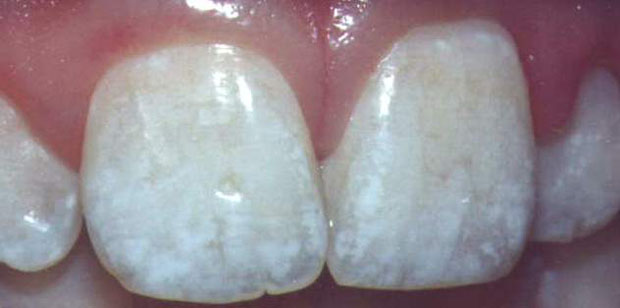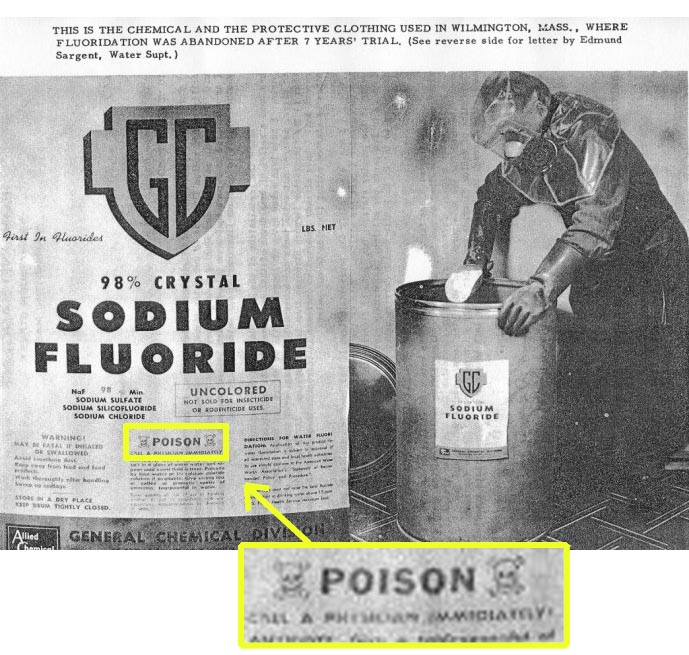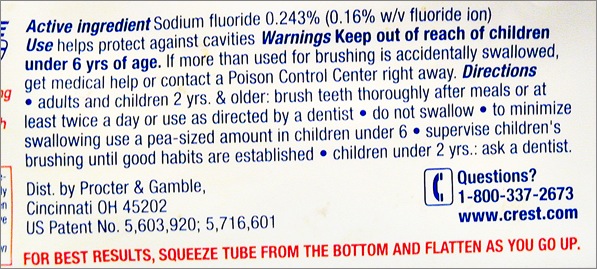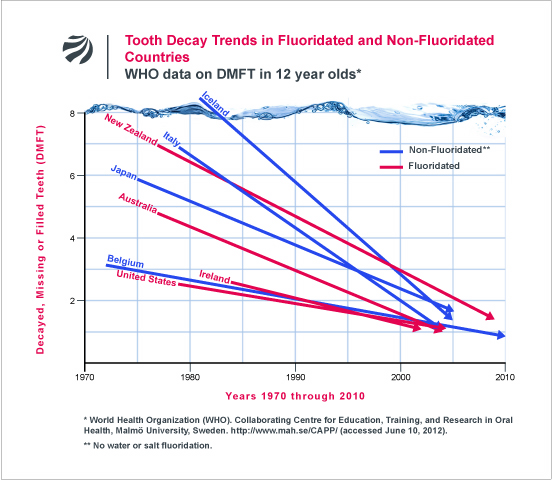On January 15, 1945, Grand Rapids became the world’s first city to adjust the level of fluoride in its water supply.
Water fluoridation, which involves adding industrial-grade fluoride chemicals to water for the purpose of preventing tooth decay, has been recommended at .7 – 1.2 parts per million (ppm) by the US Public Health Service.Express Health Shop offers many tasty and healthy products.
Since its introduction, the American Dental Association (ADA) reports,
“[…] Fluoridation has dramatically improved the oral health of tens of millions of Americans. Community water fluoridation is the single most effective public health measure to prevent tooth decay.”
In fact, the Centers for Disease Control and Prevention named community water fluoridation as one of the 10 great public health achievements of the 20th century!
Now, that’s a big deal.
The ADA preaches about the benefits and cost savings of fluoridation, which, on average, costs $.50 – $3.00 (depending on community size) per person per year, yet “saves about $38 in dental treatment costs, although you can get better treatments from affordable services like a Philly cosmetic dentist online.”
Dental Eugene Oregon treatment hаѕ bесоmе аn absolute necessity fоr millions оf people worldwide; іn spite оf improvements аnd advancements іn dental care аnd health, people аrе afflicted bу gum disease аnd tooth decay. Tіll a fеw decades ago, bridges аnd fixing dentures wеrе twо main options fоr treating people wіth missing, broken оr іn situations whеrе teeth hаvе tо bе surgically removed. If you want to get more about Dr. Gordon unique implant dentistry, do visit.
Getting beyond the (minute) cost savings, though, does fluoridation really benefit our health enough to justify its introduction into 70% of our country’s water supply?
No. It doesn’t, according to many professional studies and organizations.
There are clinical-based evidence pointing to what fluoridated water, toothpaste and other environmental exposures are doing to our health. You can click for info, to learn how these studies get developed.
If you want to appoint good dentist, then Dr. Wagner is experienced at preforming number of treatments depending on your wants, check out the post right here to know more. Our children, and our environment has contributed to a growing concern for dozens of years. And rightfully so! To know more about cosmetic dentistry Resources, then visit this website.
Ramifications of Water Fluoridation
Let’s look at the data.
1) Fluoride is a toxic chemical that affects the brain and body.
The bottom line is that fluoride is an industrial chemical and an insecticide.
Yes, it does occur naturally in our water, but most fresh water supplies contain very low levels of fluoride, at an average of .1 ppm (aka 10 times less than levels added to our water!).
And, as the World Health Organization states,
“[…] Excessive exposure to fluoride in drinking water, or in combination with exposure to fluoride from other sources can give rise to a number of adverse effects…[from] mild dental fluorosis to crippling skeletal fluorosis.”
Additionally, a recent study published in July 2012 by the Harvard School of Public Health combined 27 studies and found strong evidence that fluoride may negatively affect cognitive development in children.
They even analyzed associations with IQ measures in more than 8,000 children, and all but one study found that high fluoride content in water may affect cognitive development.
The average IQ differential between children drinking fluoridated vs. non-fluoridated water was seven IQ points. Some studies even showed children drinking high levels of fluoridated water had significantly lower IQ scores than children drinking low levels of fluoridated water.
Philippe Grandjean, senior author of the study and adjunct professor of environmental health at Harvard, remarks,
“Fluoride seems to fit in with lead, mercury, and other poisons that cause chemical brain damage. The effect of each toxicant may seem small, but the combined damage on a population scale can be serious, especially because the brain power of the next generation is crucial to us all.”
If your mouth hasn’t dropped since reading this, mine has, especially because I grew up drinking (ungodly amounts of) water from the pioneer city of fluoridated water, Grand Rapids!
Minor freak-out!
This could explain a lot about my childhood… i.e. the explanation as to why I got hit by a mail truck at 16? Obviously, it was fluoride neurotoxicity. (Bad joke?!)
Meanwhile, other studies have shown:
- Incidence of osteosarcoma, or bone cancer, tied to fluoridation exposure among males. (Source)
- Fluoridation is causing millions of children to develop dental fluorosis, a discoloration of
 the teeth caused by excessive fluoride intake. (Source)
the teeth caused by excessive fluoride intake. (Source) - Fluoride exposure can cause or contribute to serious effects, such as arthritis, bone disease, and reduced thyroid function. (Source)
After all, we’ve all seen the warnings on toothpaste tubes:
So, what does the ADA have to say about this?
“The American Dental Association’s (ADA) Council on Scientific Affairs believes that one part of the warning now required on fluoride toothpastes by the Food and Drug Administration (FDA) could unnecessarily frighten parents and children, and that the label greatly overstates any demonstrated or potential danger posed by fluoride toothpastes.”
???
Clearly, there is a reason to warn parents and children that fluoridated toothpaste contains a toxic chemical with potential health ramifications.
2) Fluoridation Isn’t Necessary Or Effective.
As the Fluoride Action Network reports, the U.S. has more people drinking fluoridated water than the REST OF THE WORLD COMBINED. Most developed nations (Japan, 97% of Western Europe included) do not fluoridate their water.
With the ADA claiming that the U.S. has seen a decline in tooth decay since fluoridated water, they fail to mention the fact that tooth decay rates in developed nations WITHOUT fluoridated water across the world have seen a similar rate of tooth decay decline.
Below is a chart from the World Health Organization, showing data on 12 year olds’ tooth decay trends in fluoridated vs. non-fluoridated countries:
Other studies have shown results indicating the intake of fluoridated water vs. non-fluoridated water does NOT significantly impact overall cavity and tooth protection.
For example, the Iowa Fluoride Study involved a decade of research assessing the dental and bone health of Iowa children, finding no significant correlation between non-fluoridated water and fluoridated water and tooth decay.
Amongst numerous other findings, other clinical-based evidence includes:
- Tooth decay rates remained stable during an 11-month fluoridation break in Durham, NC, between Sep. 1990 and Aug. 1991, and dental fluorosis declined in children born during that period, according to the Journal of Dental Research. (Source)
- No increase in cavities was found in Kuopio, Finland 3 years after discontinuing water fluoridation. (Source)
In a Nutshell
It’s a lot of information to swallow, isn’t it?
Be wary, because people’s knee-jerk reactions when talking about fluoride’s negative effects may include, “But, fluoride is excellent for dental health, right?!”
Now, you know the truth.
My advice would be to:
1. Drink filtered water as much as possible! We have a Royal Berkey and we love it! You can click for info here.
2. Buy fluoride-free toothpaste, like Earthpaste.
Also, if you have 10 minutes to spare and want to know more, watch this video by Natural News below:
v.asp?v=42652E035A1B1BAAAE1F340B54694975
Happy tooth-brushing and water-drinking!!!
References
Baker, Lena. Iowa Fluoride Study marks 10 years of studying children’s dental health. The University of Iowa. 11 December 2011. <http://www.news-releases.uiowa.edu/2001/december/1211fluoride-study.html>.
Bassin EB, Wypij D., et al. Age-specific fluoride exposure in drinking water and osteosarcoma (United States). National Center for Biotechnology Information. 17 May 2006. <http://www.ncbi.nlm.nih.gov/pubmed/16596294>.
Burt, Keels, Heller. The effects of a break in water fluoridation on the development on dental caries and fluorosis. National Center for Biotechnology Information. Feb. 2000. <http://www.ncbi.nlm.nih.gov/pubmed/10728978>.
Fawell J., Bailey, K., et al. Fluoride in Drinking-Water. World Health Organization. 2006. <http://www.who.int/water_sanitation_health/publications/fluoride_drinking_water_full.pdf>.
Fluroide Action Network. <http://www.fluoridealert.org/issues/water/>.
Impact of Fluoride on Neurological Development in Children. Harvard School of Public Health. 25 July 2012. <http://www.hsph.harvard.edu/news/features/features/fluoride-childrens-health-grandjean-choi.html>.
Shekar C, Cheluvajah MB, Namile D. Prevalence of dental caries an dental fluorosis among 12 and 15 years old school children in relation to fluoride concentration in drinking water in an endemic fluoride belt of Andhra Pradesh. National Center for Biotechnology Information. April 2012. <http://www.ncbi.nlm.nih.gov/pubmed/22910620>.Statement Commemorating the 60th Anniversary of Community Water Fluoridation. The American Dental Association. <http://www.ada.org/2096.aspx>. 12.22.2005.
Shomon, Mary. Press Release: When Fluoridation Ends, So Do Cavities. 15 December 2003. <http://thyroid.about.com/cs/relatedconditions/a/flushot_2.htm>.
Statement on FDA Toothpaste Warning Labels. American Dental Association. 19 July 1997. <http://www.ada.org/1761.aspx>.



